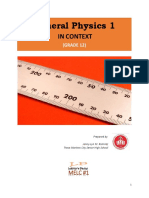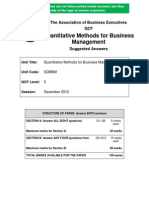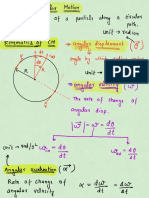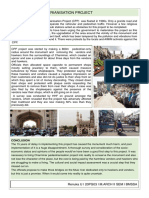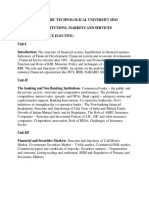Genmathq1w7 Ak
Genmathq1w7 Ak
Uploaded by
gabosara298Copyright:
Available Formats
Genmathq1w7 Ak
Genmathq1w7 Ak
Uploaded by
gabosara298Original Title
Copyright
Available Formats
Share this document
Did you find this document useful?
Is this content inappropriate?
Copyright:
Available Formats
Genmathq1w7 Ak
Genmathq1w7 Ak
Uploaded by
gabosara298Copyright:
Available Formats
1
ANSWER KEY
GENERAL
LEARNING AREA GRADE LEVEL 11
MATHEMATICS
QUARTER FIRST WEEK 7 DAY mm/dd/yyyy
TOPIC Exponential Functions and Equations
LEARNING The learner solves problems involving exponential functions and
COMPETENCY exponential equations. (M11GM-Ig-2)
Exponential Functions and Equations
Let’s Practice!
Directions: Refer to the given problem below and identify whether the given problem is
growth or decay. Answer the following questions.
The value of a car is Php 860,000.00. It loses 12% of its value every
year.
(a) Write a function that represents the value y (in php) of the car after t years.
(b) Find the approximate monthly percent decrease in value.
(c) Estimate the value of the car after 6 years.
SOLUTION
1. Solve the Problem
a. The initial value is 860,000.00, and the rate of decay is 12% or 0.12.
Write the exponential decay function ---- y = a(1 - r)t
Substitute 860,000.00 for a and 0.12 for r ---- = 860,000(1 – 0.12)t
Subtract ---- = 860,000(0.88)t
The value of the car can be represented by ---- y = 860,000(0.88)t
b. Use the fact that t =(1/12)(12t) and the properties of exponents to rewrite
the function in a form that reveals the monthly rate of decay.
Write the original function. ---- y = 860,000(0.88)t
Rewrite the exponent. ---- = 860,000(0.88)(1/12)(12t)
Power of a Power Property ---- = 860,000(0.881/12)12t
Evaluate the power. ---- = 860,000(0.989)12t
Use the decay factor 1 − r ≈ 0.989 to find the rate of decay r ≈ 0.011.
So, the monthly percent decrease is about 1.1%.
c. Estimate the value of the car after 6 years.
The value of the car can be represented by ---- y = 860,000(1-0.12)t
Substitute the values ---- y = 860,000(0.88)6
So, the value of the car is about Php 399, 387.51 after 6 years.
Michelle Ann A. Ramos, Teacher II, Cabaluay National High School
2
TRY
Let’s see how much have you learned today!
Assessment 1:
Directions: Identify the initial amount a and the rate of growth or decay r (as a percent)
of the exponential function. Evaluate the function when t = 5. Round your answer to the
nearest tenth.
1. y = 3500(1 - 0.75)t Initial Amount = 3500 rate= 0.75 Answer: 3.42
2. y = 10(1 - 0.4)t Initial Amount = 10 rate= 0.4 Answer: 0.78
3. y = 25(1.2)t Initial Amount = 25 rate= 0.20 Answer: 62.21
4. y = 12(1.05)t Initial Amount = 12 rate= 0.05 Answer: 15.32
5. f (t) = 1500(1.074)t Initial Amount = 1500 rate= 0.074 Answer: 2143.45
6. h(t) = 175(1.028)t Initial Amount = 175 rate= 0.028 Answer: 200.91
7. g(t) = 6.72(2)t Initial Amount = 6.72 rate= 1 Answer: 215.04
8. p(t) = 1.8t Initial Amount = 1 rate= 0.8 Answer: 18.90
9. y = 6(0.88)t Initial Amount = 6 rate= 0.12 Answer: 3.17
10. f (t) = 15000(0.74)t Initial Amount = 15000 rate= 0.26 Answer: 3328.51
Assessment 2:
Directions: Find the initial value and growth factor for each of the situation below then
plug them into the growth or decay model to get the function that models the problem.
1. Sales of 10,000 increase by 65% each year.
Exponential Growth/Decay Model: y = 10000(1+.065)t
2. Your starting annual salary of 35,000 increases by 4% each year.
Exponential Growth/Decay Model: y = 3500(1 + 0.04)t
3. A population of 210,000 decreases by 12.5% each year.
Exponential Growth/Decay Model: y = 210000(1 – 0.125)t
4. A 9000 sound system decreases in value by 9% each year.
Exponential Growth/Decay Model: y = 9000(1 – 0.09)t
5. A stock valued at 10,100 decreases in value by 9.5% each year.
Exponential Growth/Decay Model: y = 10100(1 – 0.095)t
Assessment 3:
Directions: Choose the letter of the correct answer and write the answer on the given
answer sheet.
For items 1-6, use the given problem below.
A bacterium grows at a rate of 25% each day.
There are 500 bacteria today.
1. What is the initial value of the given bacteria?
a. 25 b. 75 c. 500 d. 525
2. What is the rate of increase of bacteria each day?
a. 25 % b. 75% c. 500% d. 525%
Michelle Ann A. Ramos, Teacher II, Cabaluay National High School
3
3. What is the exponential growth/decay model of the given problem?
a. y= 500(1+0.25)t b. y= 500(1-0.25)t c. y= 25(1+0.500)t d. y= 25(1-
t
0.500)
4. How many will there be tomorrow?
a. 625 b. 800 c. 2384 d. 403, 896
Using the formula y = a(1 - r)t , where a = 500, r = 0.25, and t = 1 then
y = 500(1+0.25)¹
= 500(1.25)
= 625
There will be 625 bacteria tomorrow.
5. How many will there be to one week from now?
a. 625 b. 700 c. 1164 d. 2384
Using the formula y = a(1 - r)t , where a = 500, r = 0.25, and t = 7 then
y = 500(1+0.25)7
= 500(1.25)7
= 500(4.77)
=2384.19
There will be 2384.19 bacteria one week from now.
6. How many will there be one month from now?
a. 625 b. 800 c. 2384 d. 403, 896
Using the formula y = a(1 - r)t , where a = 500, r = 0.25, and t = 30 then
y = 500(1+0.25)30
= 500(1.25)30
= 500(807.79)
=403,896.78
There will be 403,897 bacteria one month from now.
For items 7-10, use the given problem below.
You buy a new computer for 21,000 php.
The computer decreases by 50% annually.
When will the computer have a value of 6,000 php?
7. What is asked in the problem?
a. initial amount b. model c. rate d. time
8. What kind of problem is presented?
a. growth b. decay c. half life d. interest
9. What is the exponential growth/decay model of the given problem?
a. y= 21000(1+0.50)t b. y= 21000(1-0.50)t c. y= 50(1+6000)t d. y= 6000(1-0.50)t
10. When will the computer have a value of 6,000 php?
a. 1 b. 2 c. 3 d. 4
“Unido, Junto avanza con el EduKalidad Cree, junto junto puede!”
Michelle Ann A. Ramos, Teacher II, Cabaluay National High School
You might also like
- A Course in Math Bio SolDocument63 pagesA Course in Math Bio SolItzalá Mendoza100% (10)
- Gen Math11 - Q1 - Mod4 - Solving Real Life Problems Involving Functions - 08082020Document24 pagesGen Math11 - Q1 - Mod4 - Solving Real Life Problems Involving Functions - 08082020Sergio Agner100% (3)
- Tranformer Oil Testing ProcedureDocument2 pagesTranformer Oil Testing ProcedureTrivesh S75% (4)
- ACTL10001 Mid - Semester-Test - 2019+solutionsDocument5 pagesACTL10001 Mid - Semester-Test - 2019+solutionsCheravinna Angesti MawarNo ratings yet
- GMQ1M23a Week 7 PDFDocument12 pagesGMQ1M23a Week 7 PDFSheridan DienteNo ratings yet
- Grade 11 Mathematics Quarter 1 - Week 7 ModuleDocument10 pagesGrade 11 Mathematics Quarter 1 - Week 7 ModuleAngelo IvanNo ratings yet
- GenMath M5 W5 Q1Document9 pagesGenMath M5 W5 Q1ariannaclarisse05No ratings yet
- Exponential FunctionDocument3 pagesExponential FunctionJunaid K JumaniNo ratings yet
- Basic Calculus - Q4 Week 3 Module 11Document10 pagesBasic Calculus - Q4 Week 3 Module 11CHRIS MARLOWE YAMBAONo ratings yet
- Q1 Week 1 FunctionsDocument38 pagesQ1 Week 1 Functionscacaljennifer33No ratings yet
- Gen-Math11 Q1 Mod1 Functions 08082020Document24 pagesGen-Math11 Q1 Mod1 Functions 08082020jNo ratings yet
- Gen-Math11 Q1 Mod1 Functions 08082020Document24 pagesGen-Math11 Q1 Mod1 Functions 08082020Jasmin MateoNo ratings yet
- Basic Calculus Q4 Week 3 Module 11Document13 pagesBasic Calculus Q4 Week 3 Module 11Christian EstabilloNo ratings yet
- Topic:: PercentageDocument22 pagesTopic:: PercentageS YESHWANTH GururajNo ratings yet
- Assessment Grade 11Document4 pagesAssessment Grade 11Shout Out DacanhighNo ratings yet
- WBS-2-Operations Analytics-W1S5-Practice-Problems-SolutionsDocument6 pagesWBS-2-Operations Analytics-W1S5-Practice-Problems-SolutionsrpercorNo ratings yet
- WEEK7DAY1Document4 pagesWEEK7DAY1niccadangcal08No ratings yet
- M2 Mathematics Summer Vacation Homework 2022Document56 pagesM2 Mathematics Summer Vacation Homework 2022Shayan SaeedNo ratings yet
- Labs TP3y06Document48 pagesLabs TP3y06api-3856799No ratings yet
- Learning Module in General Mathematics: Quarter 1 - Week 5Document4 pagesLearning Module in General Mathematics: Quarter 1 - Week 5Rostelito CatalonNo ratings yet
- Basic Calculus Q4 Week 3 Module 11Document13 pagesBasic Calculus Q4 Week 3 Module 11suzannevillasis19No ratings yet
- 2122 F3 Common Quiz 7 Ch03 + Weekly Assignment (With Sol) .Document7 pages2122 F3 Common Quiz 7 Ch03 + Weekly Assignment (With Sol) .云吸仓鼠吉尼斯保持者No ratings yet
- Core_11_General-Mathematics_q1_CLAS7_Solving-Problems-Involving - RHEA ANN NAVILLADocument16 pagesCore_11_General-Mathematics_q1_CLAS7_Solving-Problems-Involving - RHEA ANN NAVILLA2019shs0158No ratings yet
- GP1 Learners Packet WK 1 J. RamirezDocument13 pagesGP1 Learners Packet WK 1 J. RamirezAlthea Bianca BacaniNo ratings yet
- Genmath q1 Mod1 Function v2Document26 pagesGenmath q1 Mod1 Function v2Jomark RebolledoNo ratings yet
- Genmath q1 Mod1 Function v2 - EditedDocument24 pagesGenmath q1 Mod1 Function v2 - EditedMaeca BwakwningshithshsNo ratings yet
- Week1 Shs g11 1q General Math StreamlinedDocument26 pagesWeek1 Shs g11 1q General Math StreamlinedJohn Gerald CantancioNo ratings yet
- General Mathematics M1Document26 pagesGeneral Mathematics M1Ira Jane CaballeroNo ratings yet
- 5953 Fractions, Ratios, Decimals and PercentagesDocument8 pages5953 Fractions, Ratios, Decimals and PercentagesAyodele EmmanuelNo ratings yet
- Econ300 Problem SetsDocument12 pagesEcon300 Problem SetsMark VazquezNo ratings yet
- Math Gr10 Qtr1-Module-6edited Formatted 12pagesDocument12 pagesMath Gr10 Qtr1-Module-6edited Formatted 12pagesHazel LuzwellNo ratings yet
- Representing Real-Life Situations Using FunctionsDocument11 pagesRepresenting Real-Life Situations Using FunctionsBenjie PogoyNo ratings yet
- Midterm MathDocument4 pagesMidterm MathTuong TranNo ratings yet
- MathDocument26 pagesMathDenmark Mateo SantosNo ratings yet
- CST Math 2015 - Day 2 - Functions Part IIDocument22 pagesCST Math 2015 - Day 2 - Functions Part IIapi-245317729No ratings yet
- Gen - Math Q2-Module 1-2Document7 pagesGen - Math Q2-Module 1-2Angel MandigmaNo ratings yet
- General Mathematics: Quarter 1 - Module 1: FunctionsDocument20 pagesGeneral Mathematics: Quarter 1 - Module 1: FunctionsRuben100% (1)
- SAT - FinalDocument32 pagesSAT - FinalTrishjones12100% (2)
- AB1202 Quiz 3 Prep Special R-Skills v1 Nov'20oubhjnlDocument2 pagesAB1202 Quiz 3 Prep Special R-Skills v1 Nov'20oubhjnlTrash BinNo ratings yet
- Grade10 Quarter 2 Week 2.1 CompetencyDocument18 pagesGrade10 Quarter 2 Week 2.1 CompetencyMartin Jess ChavezNo ratings yet
- Dec 2012 A-QMDocument15 pagesDec 2012 A-QMShel LeeNo ratings yet
- Ancheta, Remalie V. BSSW 2A StatisticsDocument4 pagesAncheta, Remalie V. BSSW 2A StatisticsLeo VelascoNo ratings yet
- 2017 HSC Maths General 2Document40 pages2017 HSC Maths General 2Jowayne HudsonNo ratings yet
- Department of Education: General Physics 1 (Week-1) MeasurementDocument9 pagesDepartment of Education: General Physics 1 (Week-1) MeasurementMary graceNo ratings yet
- Statistics ExamDocument9 pagesStatistics ExamHasen BebbaNo ratings yet
- 1st Quiz in General MathematicsDocument2 pages1st Quiz in General MathematicsSARAH B. BALIGODNo ratings yet
- Class VI Arithmetic Practice Paper 2Document2 pagesClass VI Arithmetic Practice Paper 2Rumana KhanNo ratings yet
- Genmath q1 Mod28 Solvingreal-Lifeproblemsinvolvingexponentialfunctionsequationsandinequalities v2Document24 pagesGenmath q1 Mod28 Solvingreal-Lifeproblemsinvolvingexponentialfunctionsequationsandinequalities v2DaphneeNo ratings yet
- Ans To The Q. No. 1: Interpretation of The Direct Requirement MatrixDocument4 pagesAns To The Q. No. 1: Interpretation of The Direct Requirement MatrixSarwar AlamNo ratings yet
- GE 4 MMW Reviewer AutosavedDocument12 pagesGE 4 MMW Reviewer AutosavedKyle SarcosNo ratings yet
- Department of Education: Republic of The PhilippinesDocument4 pagesDepartment of Education: Republic of The Philippinesamarie yawnNo ratings yet
- AJ MONNETH MONREAL - BSED Math 1 - MATH 16 - Assignment. 2Document4 pagesAJ MONNETH MONREAL - BSED Math 1 - MATH 16 - Assignment. 2AJ Monneth MonrealNo ratings yet
- NCERT Solutions For Class 7 Maths 8may Chapter 8 Comparing QuantitiesDocument22 pagesNCERT Solutions For Class 7 Maths 8may Chapter 8 Comparing Quantitiesarvinda1981No ratings yet
- Review Homework: Study For The Unit Test: G (X) X + 4 G (X) 4 X +1Document2 pagesReview Homework: Study For The Unit Test: G (X) X + 4 G (X) 4 X +1Bradley SinghNo ratings yet
- Mathematics PDFDocument13 pagesMathematics PDFAj Myco Serat EstorNo ratings yet
- Genmath q1 Mod1 Function v2Document20 pagesGenmath q1 Mod1 Function v2jairusigopcastaNo ratings yet
- Approach. Pp. 8. Philippines: A WSS Senior High School SeriesDocument3 pagesApproach. Pp. 8. Philippines: A WSS Senior High School SeriesTJ gatmaitanNo ratings yet
- Mid Term TestDocument6 pagesMid Term Testsilence123444488No ratings yet
- Applications of Derivatives Errors and Approximation (Calculus) Mathematics Question BankFrom EverandApplications of Derivatives Errors and Approximation (Calculus) Mathematics Question BankNo ratings yet
- Let's Practise: Maths Workbook Coursebook 6From EverandLet's Practise: Maths Workbook Coursebook 6No ratings yet
- GenMathQ1W5 SLMDocument14 pagesGenMathQ1W5 SLMgabosara298No ratings yet
- GENMATHQ1W8Document15 pagesGENMATHQ1W8gabosara298No ratings yet
- 21.S Nuclear Chemistry SummaryDocument5 pages21.S Nuclear Chemistry Summarygabosara298No ratings yet
- Pathfit 1Document6 pagesPathfit 1gabosara298No ratings yet
- QUESTIONAREDocument4 pagesQUESTIONAREgabosara298No ratings yet
- BiographyDocument5 pagesBiographygabosara298No ratings yet
- HR CompendiumDocument16 pagesHR CompendiumRavi ChandraNo ratings yet
- Circular MotionDocument23 pagesCircular MotionAnkit PatidarNo ratings yet
- Calibration of 3phase Energy Meter Using Standard WattmeterDocument3 pagesCalibration of 3phase Energy Meter Using Standard WattmeterArjun AjuNo ratings yet
- LTE Autoclaves Floor Standing Front Loading TouchClave-R Series ManualDocument35 pagesLTE Autoclaves Floor Standing Front Loading TouchClave-R Series ManualAyungNo ratings yet
- Niko Tracks PDFDocument52 pagesNiko Tracks PDFTomekNo ratings yet
- Sejarah SeniDocument14 pagesSejarah SeniEthanNo ratings yet
- Van Dijk From Text Grammar To Critical Discourse AnalysisDocument13 pagesVan Dijk From Text Grammar To Critical Discourse AnalysisEtruscus RosNo ratings yet
- Catia V5: Compiled by Er. Bijendra PrajapatiDocument70 pagesCatia V5: Compiled by Er. Bijendra PrajapatiAnonymous uTC8baNo ratings yet
- Extraction of LeadDocument45 pagesExtraction of Leadtarity marshyNo ratings yet
- General Information: SectionDocument57 pagesGeneral Information: SectionAbraham BravoNo ratings yet
- How Do You Assess Japan As A Potential Market For ToysDocument2 pagesHow Do You Assess Japan As A Potential Market For ToysBalachandra MallyaNo ratings yet
- St-Pro1 2012 PDFDocument379 pagesSt-Pro1 2012 PDFbeihanNo ratings yet
- Iadr Final Report Group 2Document16 pagesIadr Final Report Group 2chetan gidwaniNo ratings yet
- Charminar Pedestrianisation Project SummaryDocument2 pagesCharminar Pedestrianisation Project SummaryRENUKA UNo ratings yet
- Book GlobalcompetenceDocument136 pagesBook Globalcompetenceapi-290985479No ratings yet
- 400 MM Dia Pipe DwarkaDocument4 pages400 MM Dia Pipe DwarkajayantaNo ratings yet
- VMware AirWatch Browser Admin GuideDocument31 pagesVMware AirWatch Browser Admin Guideforum4userNo ratings yet
- Contractor Safety Management System: (CSMS)Document21 pagesContractor Safety Management System: (CSMS)ochee2toneNo ratings yet
- Fundamentals of Accountancy, Business and Management 1: Module No. 3: Week 3: Second QuarterDocument6 pagesFundamentals of Accountancy, Business and Management 1: Module No. 3: Week 3: Second QuarterCrestina Chu BagsitNo ratings yet
- Advanced Manufacturing Technology." University QuestionsDocument10 pagesAdvanced Manufacturing Technology." University QuestionsGunabalan SellanNo ratings yet
- The Impact of Globalization On Economic Development of Developing Countries: A Case of NigeriaDocument13 pagesThe Impact of Globalization On Economic Development of Developing Countries: A Case of Nigeriakolawolebashir100% (13)
- Financial Institutions Markets and ServicesDocument2 pagesFinancial Institutions Markets and ServicesPavneet Kaur Bhatia100% (1)
- Mapping Diasporas: Jewish Culture, Museums, and Digital Humanities - Syllabus Spring 2019Document6 pagesMapping Diasporas: Jewish Culture, Museums, and Digital Humanities - Syllabus Spring 2019spagnoloachtNo ratings yet
- Vulcan VC4GDocument2 pagesVulcan VC4GPaulo AgustoNo ratings yet
- Engineering Graphics & Design Manual (3110013) : Govt. Engg. College, ValsadDocument21 pagesEngineering Graphics & Design Manual (3110013) : Govt. Engg. College, ValsadPratik PawarNo ratings yet
- 1st Week ModuleDocument17 pages1st Week ModuleMarnie Godienes100% (1)
- Set Theory and Logic Sample QuizDocument2 pagesSet Theory and Logic Sample QuizDiana Grace AnibanNo ratings yet
- Skm400gal124d Semikron Igbt ModuleDocument6 pagesSkm400gal124d Semikron Igbt ModuleElectronics Learn and FunNo ratings yet
- Mind MapDocument1 pageMind MapRumbling QueenNo ratings yet























